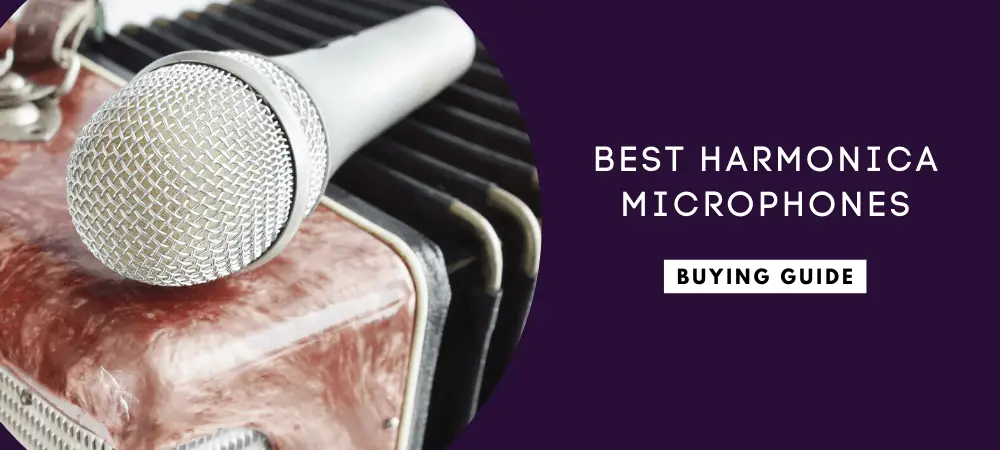You might want to be heard better, you might want to change your tone, or you might want to record your session.
How do you go about selecting the right harmonica microphone, though?
Well, it all depends on what you want to sound like.
Now, let me explain.
Table of Contents
Best Harmonica Microphones In 2024
All harmonica players know of the Shure Green Bullet, so how could we not have it at number one on our list?
If you need to control your microphone’s output while performing, then this is just the mic you need.
This bullet mic has excellent sound quality, and it is a perfect option for blues harmonica players as well as jazz musicians.
The high output means that this microphone will drive the amp super hard, thereby capturing that big crunch of an overdriven tone.
- Has hardwearing durability
- Features a retro design.
- It has a volume knob.
- It comes with a long 20-ft cable.
- It can be cupped easily.
- The best harmonica sound output (My favourite anyway :))
- It cannot be mounted on a stand.
If you find the Shure Green Bullet to be a bit too expensive for your liking, then the Superlux D112/C will be a suitable alternative.
The Superlux is an excellent harmonica price that’s affordably priced.
So, consider this mic a budget version of the Shure Green bullet, which makes it a perfect option for novices.
This omnidirectional mic has a comfortable ergonomic design and can pick up the full range which any harmonica can reach.
Being a high impedance mic, it can conveniently be used with a guitar amp to bring the tones of your harmonica to life.
The 20-ft cable gives you plenty of allowances to move around on stage, so that’s a good thing.
All in all, I consider the Superlux D112 to be the best budget harmonica microphone. I do not think that’s a wild statement given the popularity of this mic among harmonica enthusiasts.
- Durable metal construction.
- Affordably priced.
- Easy-to-hold bullet mic design.
- Has a volume knob.
- Weighs just 1.43 pounds
- The volume knob is a bit harder to overdrive.
This BlowsMeAway VC Harmonica Mic by Bulletini is an incredibly small microphone, which makes it quite a joy to hold.
The mic is roughly 2/3 the size of a Shure Green Bullet, so trust me when I say that it is incredibly small.
Which is an excellent thing because this makes it effortless to cup and hold the mic even when recording for long hours.
Besides the small size, the other impressive feature is that it comes with a Heumann Element.
Now, here’s what you need to know, the Heumann Element is the only element that’s ever been developed specifically for harp players.
As a result, this mic delivers big fat tones with plenty of bass.
- Custom designed for harp players.
- It is designed to prevent feedback.
- Has a volume knob.
- Incredibly small.
- Excellent harmonica sound quality.
- The screw-on cable is not included.
The minute you hold the Shaker Dynamic, you will notice that its very lightweight.
Well, this is because the microphone is constructed with a plastic shell.
While plastic reduces the weight of the microphone, the trade-off is that the microphone is then less sturdy.
Likewise, the mic is also less able to withstand abuse.
Nevertheless, this versatile mic can drive nearly anything it is plugged into.
Besides, the volume knob also allows you to adjust accordingly, depending on the venue in which you are playing.
- Has minimal feedback.
- The volume control has micro-detents.
- Very lightweight.
- Compact and easy to handle.
- Flat and crisp harmonica sound output.
- The plastic shell isn’t very sturdy.
If you are yet to find the ideal harmonica miking technique that suits your style of play, then perhaps you ought to give the Feather Soul microphone a try.
Designed by Myers Pickups, this hands-free harmonica microphone is the first of its kind.
This mic doesn’t mount on a stand. Neither do you, suspend it from the ceiling, or cup it in your hands.
Instead, the mic is designed to slip onto one of your fingers for a comfortable feel.
This way, the harp player gets complete mobility because the mic doesn’t impede the use of your fingers or hands while playing.
- Extremely portable.
- Hands-free design.
- It allows for easy positioning while playing.
- It has excellent fidelity.
- Produces flawless sound and tone.
- A bit costly.
The Peavey H-5C is a bullet-style microphone whose tone and quality of sound is comparable to what you get when using the Green Bullet.
Unlike the Shure Green Bullet, however, the Peavey H-5C costs slightly less.
The Peavey H-5C also has a more professional tone, which some players prefer. It’s an excellent harmonica microphone that will certainly do the job.
The contoured shell of this cherry bomb red mic comes with finger placement grooves, and there is a volume control knob as well.
One thing to note is that the Peavey H-5C weighs a shocking 3 pounds, which makes it one of the heaviest microphones in the market.
- Very solid construction.
- It comes with a case.
- Gives a professional-sounding tone.
- Has a volume knob.
- Very sensitive.
- It’s quite heavy.
Audix designed this microphone with the harmonica playing beatboxer in mind.
This is a professional-level harmonica mic, and it costs a pretty penny too.
The mic delivers very clean tones, so do not grab it expecting to get the distorted sound of a bullet mic.
- Designed to prevent feedback.
- Small, lightweight build.
- Professional-grade.
- Very clean tones with no sound distortion.
- It comes with a 5-year warranty.
- For amplification, you’ll need a low to high impedance transformer.
Did you know that the Shure SM58 Microphone is largely considered the most popular mic in the world?
Designed for professional use, this microphone minimizes unwanted background noise, including wind and breath pop noises.
Just as well, Shure SM58 mic features pneumatic shock-mount systems that cut down handling noise.
The Shure SM58 is widely used among harmonica players and even some consider it to be one of the best harmonica microphones in the market today.
- Extremely durable mic.
- It is designed to minimize background noise.
- Bright tones with no feedback.
- Has a robust mesh grille.
- Performs consistently both indoors and outdoors.
- It doesn’t come with a cable.
This harmonica microphone by BadAax is a professional-grade mic expressly tailored to produce thick, warm tones.
The contoured shape allows for easy cupping, while the volume knob makes it easy to create different audio effects while performing.
The wide dynamic range of this mic makes it suitable for harmonica players.
However, it can also be used as a vocal mic, thereby allowing for versatile use on stage.
- Vintage-style design.
- Comes with a velvet carrying pouch.
- Has a volume knob.
- Delivers good distortion ideal for blues harmonica players
- It has decent sound quality.
- It’s not very durably built.
Much like the BadAax ZD-2, the Apex 327 is a nice-looking vintage style harmonica microphone.
Its small, compact design makes it easier to cup this mic in your hands so that you can hold it with more ease.
Additionally, the high impedance design means that this mic has enough grain to drive a guitar amp with plenty of grit.
The attached 20-ft cable makes it easy for the harp player to move around on stage while performing.
Also, the volume knob is easily accessible, thereby making it easy to make grain adjustments on the fly.
- Vintage bullet-style design.
- The shell is solid and durable.
- Small compact design.
- It comes with a padded carrying bag.
- It has a long 20-ft cable.
- The sound quality isn’t very impressive.
Why Use A Harmonica Microphone?
Audibility
When playing in a band with amplified musicians, it might be hard to hear the harmonica over all the other instruments.
For this reason, a harmonica microphone may be used to amplify the sound of the harp so that it is as audible as the other instruments being played.
This has to be done skilfully because if the mic and amp are not compatible, there could be some horrendous feedback (loud screeching sound), and nobody wants such a scenario.
Sound distortion
This may seem like a strange concept, but yes, a microphone may be used for the sole purpose of distorting the harmonica’s sound.
Sound distortion isn’t always a bad thing. In this instance, using a microphone to distort the tones of a harmonica would result in a fatter, saxophone-like sound similar to that found in the “Chicago Blues” style of music.
Having been popularized by Little Walter, this style can be created using a combination of factors.
These are overdriving the mic, the amp speakers, the amp tubes, and the harmonica itself. Proper breathing, single note, and your general playing technique should essentially get you there.
Amplification
First of all, keep in mind that there is a difference between increasing a sound’s volume and amplifying a sound.
Amplification refers to increasing the amplitude of a signal, which in this case, means making lower-pitch tones more noticeable.
See, when you play two notes on a harmonica, the 3rd note called the “difference tone” is produced.
The two fundamental notes tend to have a higher pitch than the difference tone, so it’s not likely that you’ll even hear it.
However, with a good microphone and amplifier, the difference note can be heard just fine once it’s been amplified.
Depending on your technique, amplification of a harmonica, therefore, adds bassy difference tones into the mix, making your sound that much more vibrant.
Bullet Mics Vs. Vocal Mics: Learn The Difference
Bullet Mics
Did you know that bullet mics were initially designed for dispatch use by police and taxi drivers? Did you also know that they are so-called because of their shape?
Around the late 1940s, blues bands became increasingly electrified, and this led to bullet mics becoming very popular among harp players.
The incline towards bullet microphones resulted from the fact that these mics were inexpensive, and the shape of the mic lent itself to being cupped.
Using the mic involved plugging it into various tube guitar and bass amps, and the musician then played by cupping their hands tightly around the mic and harp. This cupping produced a fat, distorted sound that’s now synonymous with the Chicago-style blues tone.
Bullet mics might have been preferred earlier on because they were inexpensive, but that is no longer the case.
It is difficult to get a hold of the original bullet mics. Not to mention that they are quite expensive as well.
The good news is that there are modern bullet microphones that look virtually identical to the originals.
However, bullet mics are not for everybody. Players with smaller hands may struggle to get an airtight grip around the mic.
Vocal Mics
You might be more familiar with vocal mics seeing as these are the popular microphone design, having a small head and a long handle.
A vocal mic is the typical one used for singing. This one will work just fine, seeing as microphones that work well for vocals also tend to work well with harmonicas.
When picking out a vocal microphone for use with a harmonica, you would have to go for a low impedance mic that has an XLR connection at the base.
This specific type of vocal microphone has balanced lines for noise cancellation and mitigation of signal loss.
The result is high-quality sound, which is just what you want to hear when playing your harmonica through a microphone.
On the other hand, a low impedance mic is often not a good fit for most guitar amplifiers, and the sound may come off as muddled.
So, when using the mic with a guitar amp, you may need to go for a high impedance vocal mic.
To use a vocal microphone, you may mount it on a stand, or cup it with the harp.
Comparison
Vocal microphones are much more common, and they are also cheaper than their bullet counterparts.
When cupping, vocal mics have the advantage of having a smaller diameter than bullet mics. As a result, they are easier to cup while playing the harmonica.
Additionally, it’s easier to get an acoustic-style tone when using a vocal mic. Bullet mics are better suited for getting a bit of extra distortion.
What to Look for When Buying Harmonica Microphone
a) Size and Shape
When cupping a mic, the aim is to achieve a good seal around it. An excellent airtight grip will increase the volume of your harmonica, in addition to providing more vibrant tones.
So, to achieve this, you need to consider whether you will be able to fully cover the mic on the sides as you play. The mic shouldn’t be too heavy to hold either.
b) Polar Pattern
Most vocal mics tend to be directional, i.e., are designed to pick up more sound from the front rather than from the sides and rear of the mic.
Often, the reason behind a directional mic is to avoid feedback on stage, but this only works if the mic is to be used in free air, mounted on a stand.
Because most harmonica players end up playing by cupping their microphones, then you don’t need to worry about getting a directional mic.
When using the cupping technique, you can easily get away with using an omnidirectional mic on live stage.
c) Output Level
A high output level translates into more power, and this yields a more powerful sound. What this means is that your harmonica tones will have that extra oomph.
On the downside, a high output level may lead to howling feedback, and so therein lies the challenge of finding that sweet spot for your sound.
d) Volume Control
This may seem like a luxury, but it is actually a necessity when it comes to selecting which harmonica mic to buy.
Having a volume knob on the mic allows the player to make the necessary adjustments so that they can get the best proximity effect.
Ideally, the proximity effect dictates that as a directional mic gets closer to the sound source, there will be an increase in its bass-frequency response.
The proximity effect could work for or against you, depending on the sound effect you desire to achieve, and a volume knob on the mic would help you tweak it to your liking.
The best microphones having a volume knob will give you the advantage of being able to manipulate the volume without altering the tone.
If you will not need to manipulate the mic’s volume (such as if the sound is to go through a mixing desk that’s controlled by a sound engineer), then no need to worry about getting a mic with volume control.
e) Presence Boost
A sound can either be present or distant and when recording or playing on stage, the presence or distance of a sound will rely on the sensitivity of the microphone being used.
3-6 kHz is usually considered the ‘presence band’ of audible frequencies meaning this range allows for more comprehensible tones that are more appealing to a listener.
Therefore, when it comes to microphones, their presence is determined by how responsive and sensitive they are to this 3-6 kHz band.
A mic with ‘good presence’ will boost this range, thereby allowing vocals to cut through denser mixes.
This is especially important when playing with a cupped mic. Cupping tends to boost low and low-mid frequencies while cutting the presence of high-end frequencies, thereby giving you the desired sound output.
f) Headroom
A microphone’s headroom is the ability to tolerate higher sound pressure levels without distorting.
Therefore, a mic with a lot of headroom will distort less. However, high headroom could work against you as well, seeing as it can prevent the player from overdriving the microphone.
g) Price
It seems like a no-brainer, but the price is still an essential factor to take into consideration.
Gear can be expensive, and harmonica microphones are no exception. The price of a particular mic should match your skill level.
So, if you are a beginner, there is no need to go for a very expensive microphone.
Besides, you may end up realizing that there are very minimal differences between an expensive mic and a cheaper option.
Another thing to note is you might want to go for a microphone which you can afford multiples of.
This applies to both harpists, audio technicians, and venue owners, who make a living through their equipment.
FAQs About The Best Harmonica Microphones
How Do You Hold A Mic on Harmonica?
Cupping is a learned skill that involves much more than merely getting the mic to your mouth.
When playing the harmonica into a cupped microphone, proper technique is essential because this is what produces the fullest, warmest tones.
You need to create an airtight seal around the back of the harp while still using your hands to control the harmonica’s tone and volume.
Your playing techniques, combined with your cupping techniques, can give effective combinations for various tonal effects, voices, feeling, and emphasis.
When using this miking technique, the rule of thumb is to hold the microphone one finger width away from the harp. This keeps the harmonica from bumping into the mic and making noise.
Here’s how you should go about cupping both your mic and harmonica:
Step 1: Taking the microphone into your left hand, hold it between your palm and your last two fingers (pinky and ring finger). The mic is not supposed to come up beyond your middle finger.
This technique of holding the mic applies to both bullet mics and vocal stick mics.
This middle finger shall act as the distancing buffer between the mic and the harmonica, so ensure that the mic doesn’t go up past it.
Step 2: Take the harp into your left hand, gently holding it between your thumb and index finger, and let these two fingers run the length of the harmonica.
To know that you are doing it correctly, both fingers should be pointing to the right side of the harp. Make sure you’re holding the harmonica with the slide to the right, holes facing you, and hole numbers visible on the top cover.
Step 3: Bring your right hand to cup your left one, cover any openings, and creating a good seal around it.
Adjust your hands accordingly so that you’re comfortable but without compromising the airtightness of the chamber you’ve created.
You can use this video to make sure you’re holding both mic and harmonica the correct way.
Does the Microphone Need to Be Centred on The Harp?
No, it doesn’t.
What Are the Advantages of Cupping the Microphone?
Holding the mic in your hands together with the harmonica makes your sound louder, stronger, and more concentrated, all the while maintaining the instrument’s natural tones.
Besides, cupping is a better method than playing acoustic because, with the former, you get to block out other loud sounds (e.g., drums and guitars) from getting into your mic.
Another advantage is because the mic goes where you go, cupping allows you to move around on stage while performing.
Are There Any Disadvantages to Cupping the Mic?
Yes, there are.
For starters, cupping limits your ability to shape tones seeing as the mic now occupies the space in your hands that’s needed to create an acoustic chamber.
Also, when playing with a cupped microphone, there tends to be less of a distinction between loud and soft sounds.
You might also notice that the tone of your harmonica chances when using this mic holding technique. Because higher frequencies are now less pronounced, your tone will sound darker and mellower.
Conclusion
The best harmonica microphone ought to be light, small, compact, and have excellent sound quality.
Always remember that excellent amplified sound quality doesn’t merely rely on the quality of the microphone.
It also depends on your playing technique, and your miking technique as well.
You might not get it right with your first try, and that’s alright. Don’t fret.
As long as you have the right equipment, though, just keep at it, and you’ll be a pro at playing amplified in no time.
















